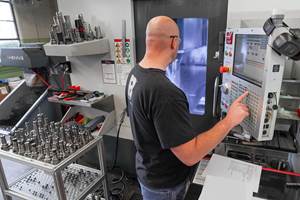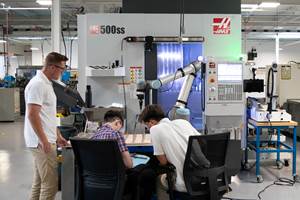Communicating the Value of Time Is the Key to Online Job Quoting
Online digital tools that automate the quote-to-order process must help job shops and their customers agree on the value of time.
Share






How much will the parts cost? A buyer looking for a source of prototypes or small batches of parts is likely to have a keen interest in this question. In fact, the main intent for requesting a quote from a potential job shop supplier is usually to get this answer. To respond, most job shops follow their usual, manual-quoting processes, which typically involve estimating the costs involved to come up with a unit price.
However, there is a fundamental flaw in this approach, says Jason Ray, cofounder and CEO of , a two-year-old company dedicated to helping job shops automate the quote-to-order process. Mr. Ray explains that the traditional quoting process makes it easy for neither the customer nor the job shop to ask the right questions and get answers with all the right information. A price per part is one of many factors both sides need to consider.
What’s needed, he says, is a better method for both parties to reach an agreement on the value of time. When the customer and the shop agree on this point, the buying decision is far more likely to please and benefit both parties.
This, he says, is the insight underlying the online digital tools his company has developed to transform and automate the quote-to-order process. “The goal is to enable job shops to optimize the procurement experience for the customers, and of course, to maximize the profitability of the job shops’ operations,” he says.
The value of time seemed to be an important concept, so I asked Mr. Ray to elaborate. He offered this simple analogy: When you ship a package, you understand that overnight, two-day or standard four-day delivery will have different prices. The sooner you want the package delivered, the more it will cost. If the package needs to arrive, let’s say on or before a loved-one’s birthday, the costlier but faster delivery option is welcome. This is the value of time.
A job shop’s quote must also convey the value of its production time to customers. “This means giving the customer clear, unambiguous options for expedited service. For example, parts that can be delivered in 12 days will cost 10 percent more if delivered two days sooner, 20 percent more three days sooner and 40 percent four days sooner,” he explained. He added that the quote must include an expiration date. “The customer who wants parts in 10 days can’t wait two days to accept the quote and then expect parts in only eight days.”
So, preparing a quote has to be a very quick, but reasonably accurate process, Mr. Ray says. For this reason, his company has developed an “intelligent pricing engine” designed to interpret a CAD model and apply cost variables in a template customized by the shop to reflect its capabilities and constraints. This engine, he says, combines algorithms based on part geometry as well as knowledge of the shop’s most experienced estimator(s). Additional formulas provide the figures for expedited options that consider the impact of lead times on overall shop scheduling and capacity.
Equally important, he says, is a streamlined, automated method for “packaging” the quote online to generate it in an attractive, customized format. This way, a detailed quote can be emailed in very little time. Mr. Ray reports that current shop users are often getting customer orders placed in fewer than two hours using the integrated online ordering system.
His main point though was not to pitch Paperless Parts, but to emphasize that communicating the value of time, in this context, is critical. “It’s not all about machining cycle times or lowest unit cost. It’s about taking the friction out of the interaction between the job shop and its customer. Digital tools and access to complete data take the back-and-forth exchanges out of the ordering process, so then the chips can fly.”
Related Content
Investing in Automation, Five-Axis to Increase Production Capacity
To meet an increase in demand, this shop invested heavily in automation solutions and five-axis machines to ramp up its production capabilities.
Read MoreMedical Shop Performs Lights-Out Production in Five-Axes
Moving to five-axis machining enabled this shop to dramatically reduce setup time and increase lights-out capacity, but success relied on the right combination of workholding and automation.
Read MoreCNC Machine Shop Honored for Automation, Machine Monitoring
From cobots to machine monitoring, this Top Shop honoree shows that machining technology is about more than the machine tool.
Read MoreLean Approach to Automated Machine Tending Delivers Quicker Paths to Success
Almost any shop can automate at least some of its production, even in low-volume, high-mix applications. The key to getting started is finding the simplest solutions that fit your requirements. It helps to work with an automation partner that understands your needs.
Read MoreRead Next
AMRs Are Moving Into Manufacturing: 4 Considerations for Implementation
AMRs can provide a flexible, easy-to-use automation platform so long as manufacturers choose a suitable task and prepare their facilities.
Read MoreMachine Shop MBA
Making Chips and Modern Machine Shop are teaming up for a new podcast series called Machine Shop MBA—designed to help manufacturers measure their success against the industry’s best. Through the lens of the Top Shops benchmarking program, the series explores the KPIs that set high-performing shops apart, from machine utilization and first-pass yield to employee engagement and revenue per employee.
Read More

















